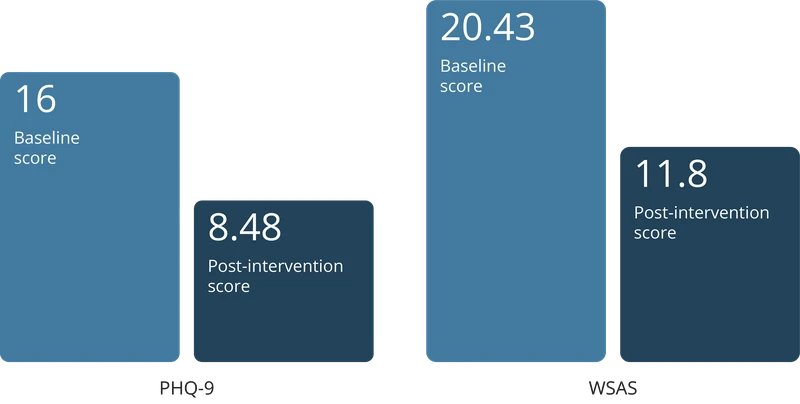57.5% achieved remission in 10 weeks
From recent clinical trial1, NHS pilots2, and over 30,000 real-world users3, Flow has repeatedly been shown to support reducing depressive symptoms.


Efficacy of Flow in clinical trials
Results at 10 weeks from a multisite, double-blind placebo-controlled randomised superiority trial were statistically significant for both primary and secondary endpoints. Flow achieved a 57.5% remission rate using the MADRS scale and was effective as both standalone and adjunctive therapy.1

Potential amplification when augmented
The EMPOWER clinical trial also showed Flow can have an enhanced effect when supplemented with an antidepressant. More research is needed to examine this further. This impact has also been reported in real-world cases.

Open-label results yield similar impacts
Open-label patient cohort study in an NHS primary care general practice found at 6 weeks:2
- 58.1% of patients showed reliable improvement, and 32.3% achieved remission using the PHQ-9
- Significant improvements were observed in functioning (WSAS) and health-related quality of life (EQ-5D-5L)

Results are replicable in the real world at scale
A 10-week review of 2,000+ Flow users revealed the overall composition of depression severity shifted dramatically over the 10-week period3. At the start, 20% of patients had severe depression, 65% were moderate, and 15% were mild. By Week 10, only 6% remained in the severe category, with 38% of all patients reaching remission—demonstrating Flow’s ability to significantly reduce symptom severity across all patient groups.
It is important to note the results reflect that patients with milder symptoms require a smaller point reduction to reach remission, while those with severe depression need more significant improvement to achieve the same result.
Experience the Power of Flow in Your Practice
Neuromodulation is transforming depression care, and Flow makes it easier to integrate into your clinical practice. We offer complimentary training, dedicated clinical support, and a demo device, allowing you to experience the benefits of Flow firsthand. From reducing symptoms to improving patient outcomes, Flow is designed to make a real difference.
Ready to explore how Flow can enhance your treatment pathways? See how our proven approach to depression treatment can fit seamlessly into your care model.
Wider depression focused tDCS research
References:
1. Woodham, R.D., Selvaraj, S., Lajmi, N. et al. Nat Med (2024).
2. Griffiths, C. et al. (2024). Open Journal of Depression. 13(02), 25–39.
3. Data on file. Flow Neuroscience Real-world reports.


